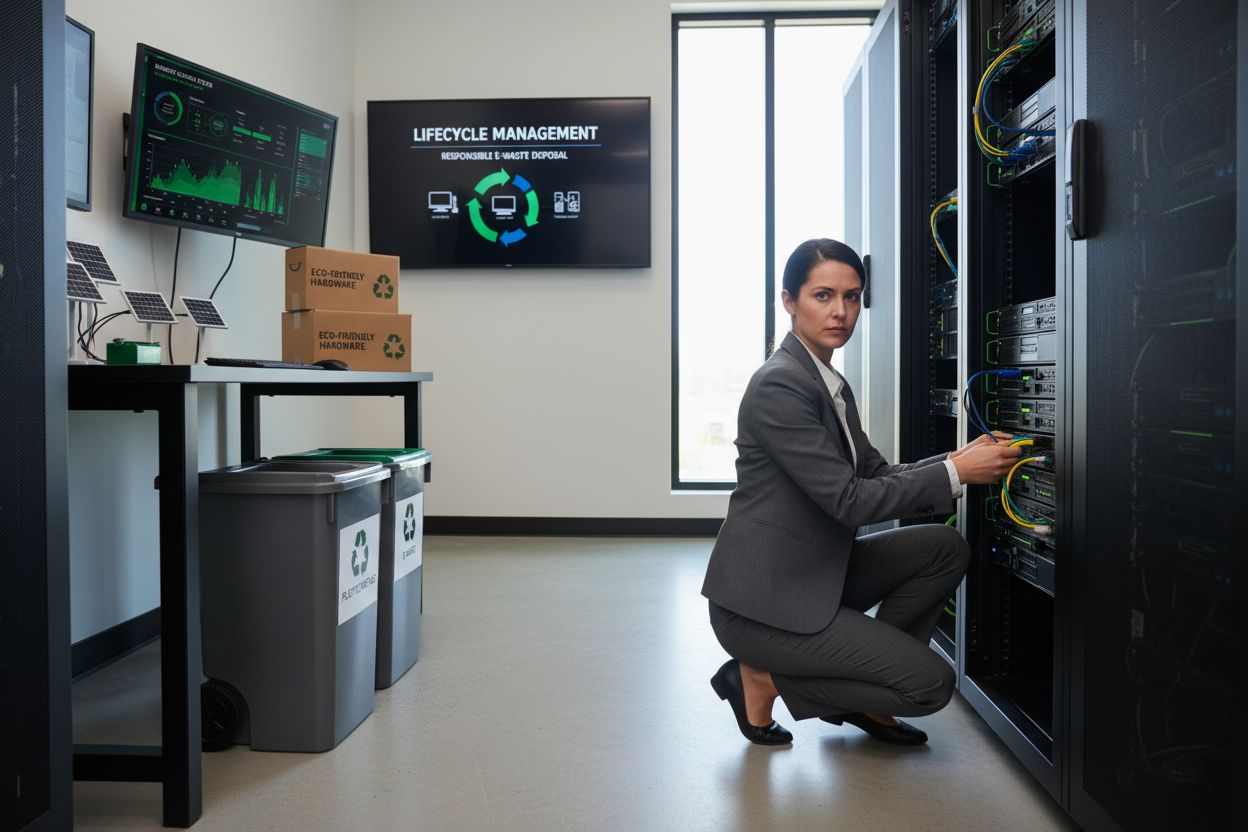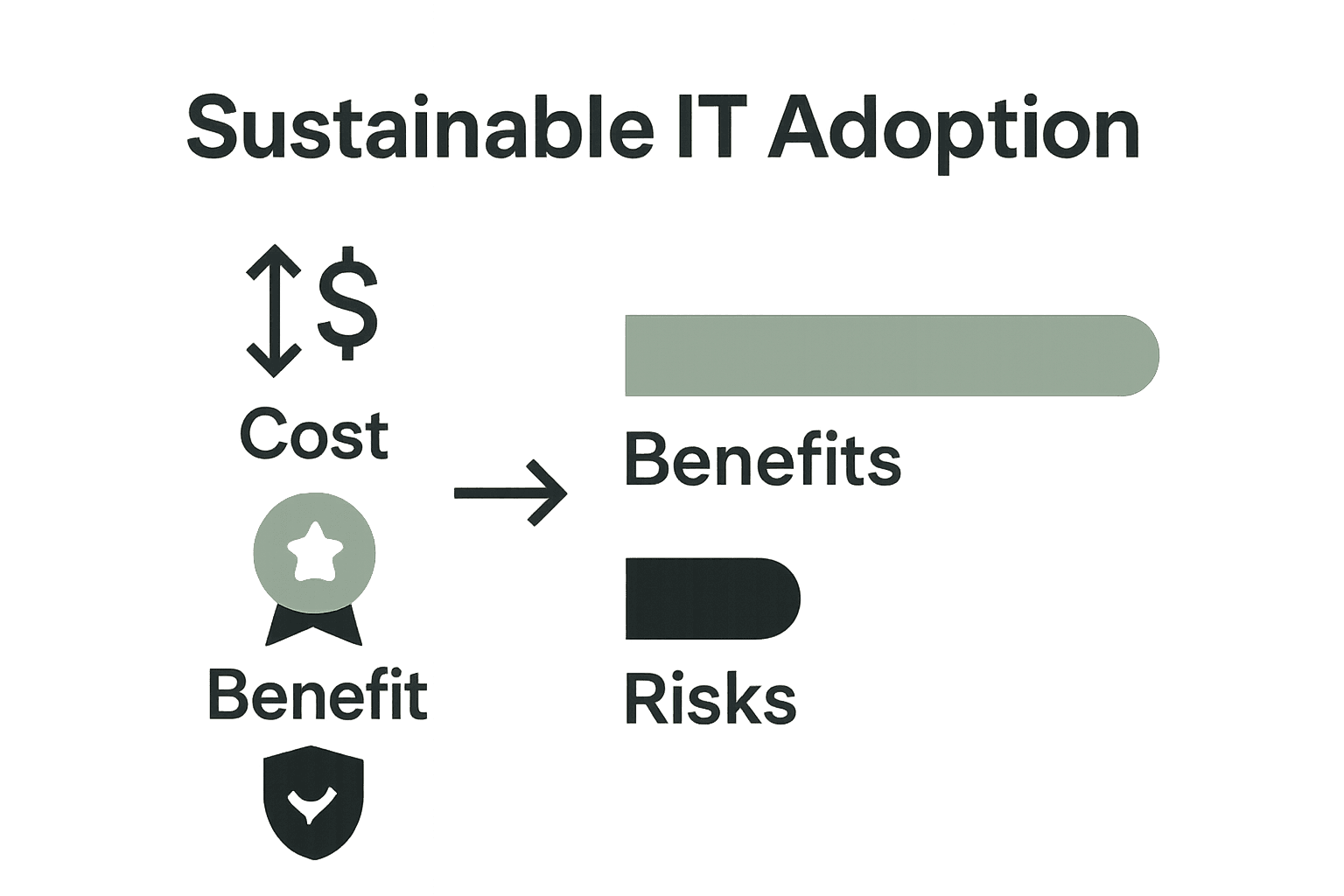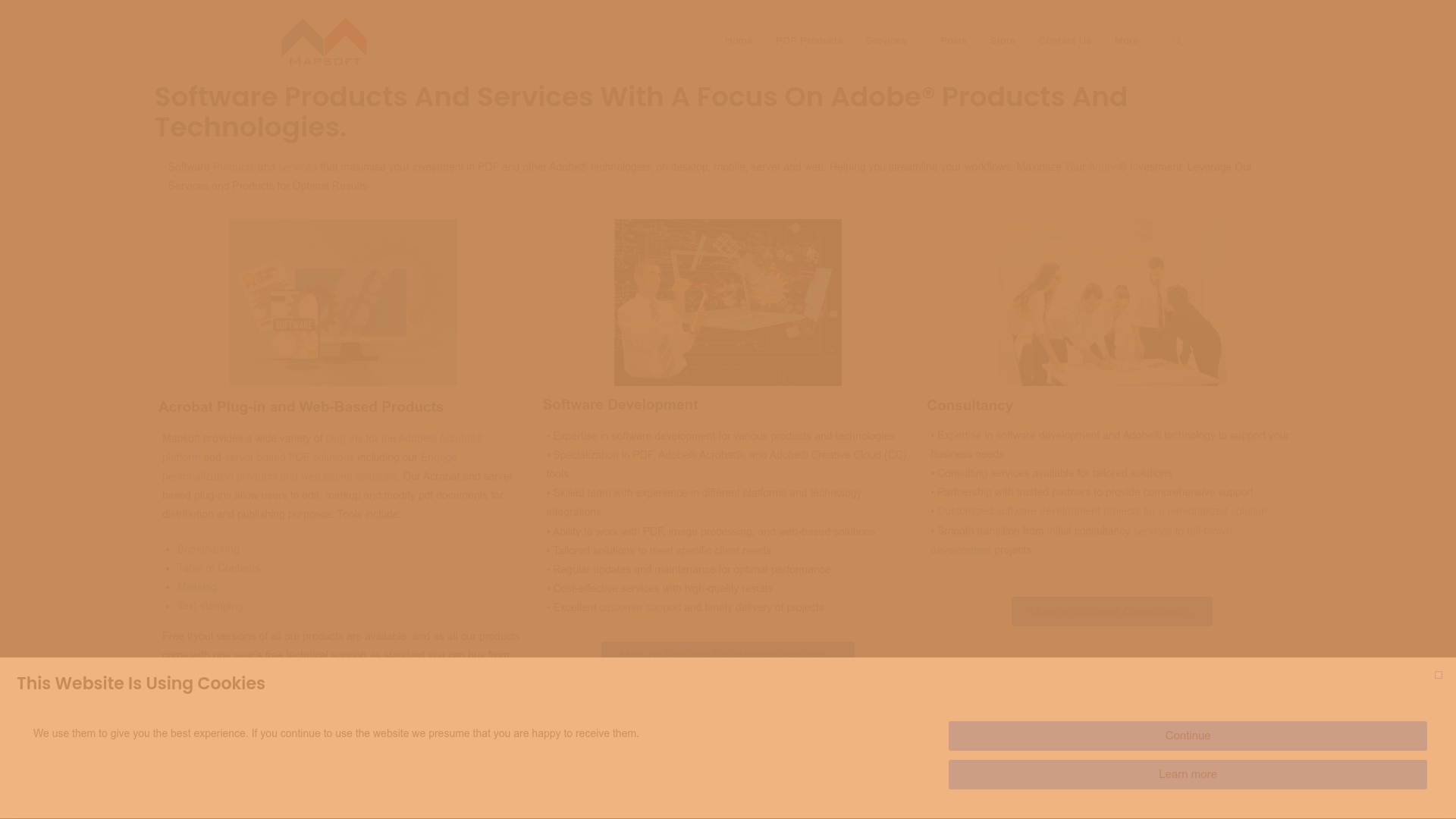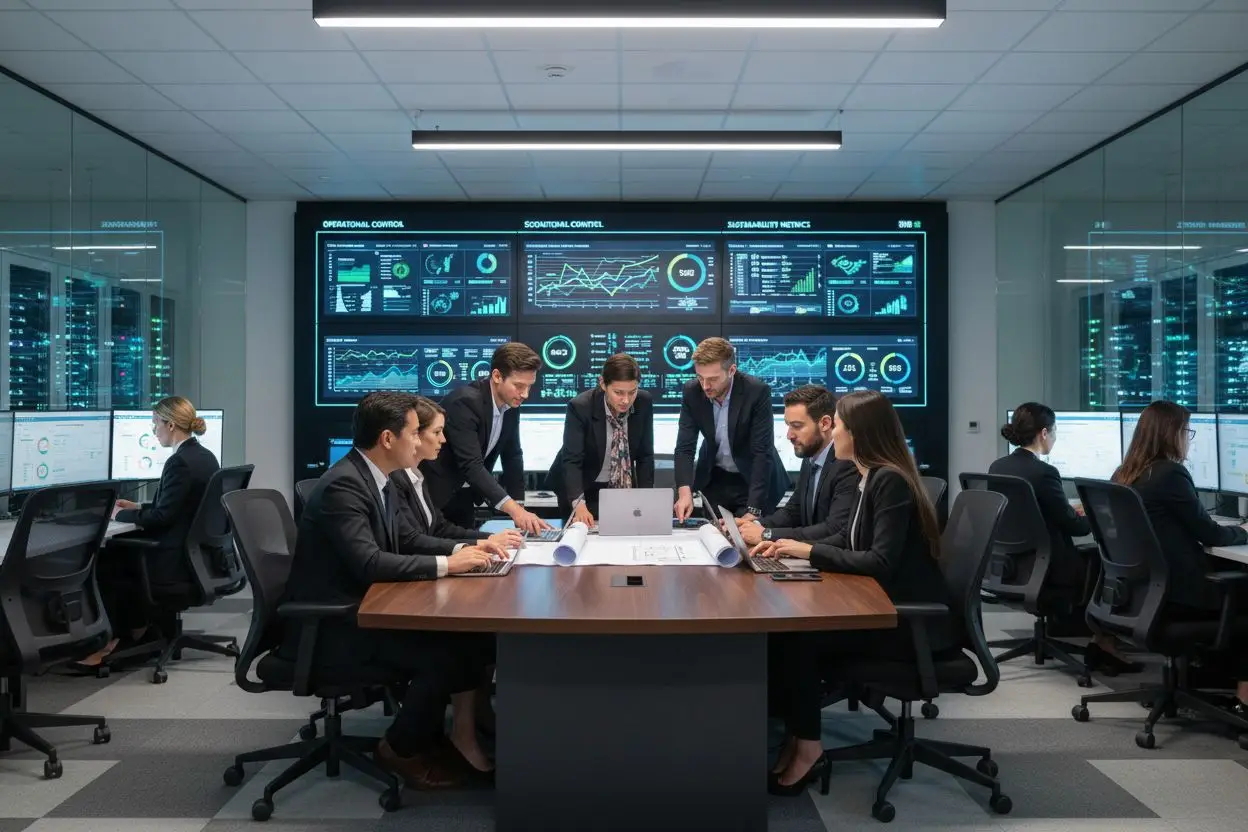Did you know that global data centers use about 1 percent of the world’s electricity each year? The growing impact of technology on our environment is no longer just a concern for large corporations. As more businesses and individuals rely on digital devices, the push for greener and more responsible tech practices is stronger than ever. Adopting sustainable IT means making smarter choices that help the planet and can make a real difference in how technology shapes our future.
Key Takeaways
| Point | Details |
|---|---|
| Sustainable IT Focus | Prioritizes environmental responsibility by reducing technology’s carbon footprint through energy efficiency and responsible lifecycle management. |
| Key Sustainable Practices | Implement energy-efficient hardware, integrate renewable energy, and emphasize modular design to promote longevity and reduce waste. |
| Operational Requirements | Develop frameworks for energy management, resource allocation, and compliance tracking to embed sustainability into organizational culture. |
| Strategic Business Benefits | Sustainable IT transforms environmental responsibility into a competitive advantage, enhancing brand reputation and attracting talent while potentially lowering operational costs. |
Table of Contents
- What Sustainable IT Practices Mean
- Types Of Sustainable IT Practices
- Lifecycle Strategies In Sustainable IT
- Operational Requirements And Obligations
- Risks Costs And Benefits
- Alternatives And Comparative Practices
What Sustainable IT Practices Mean
Sustainable IT represents a strategic approach to technology management that prioritizes environmental responsibility and reduces the digital carbon footprint of corporate operations. Green computing isn’t just a trendy buzzword – it’s a comprehensive framework for designing, implementing, and managing technology infrastructure with ecological consciousness.
According to IBM, sustainable IT aims to minimize the environmental impact of technology by focusing on key areas like energy efficiency, renewable energy integration, and responsible equipment lifecycle management. This approach encompasses multiple dimensions of technological practice:
- Designing energy-efficient hardware
- Implementing virtualization technologies
- Reducing electronic waste
- Selecting renewable energy sources for data centers
- Developing software with lower computational resource requirements
Research from Wikipedia highlights that green computing goes beyond simple energy conservation. It represents a holistic strategy supporting circular economy goals by emphasizing product longevity, reparability, and recyclability. For enterprise technology managers, this means making strategic choices that balance performance, cost, and environmental stewardship – transforming sustainability from an abstract concept into a practical operational strategy.
Types Of Sustainable IT Practices
Sustainable IT practices represent a multifaceted approach to reducing technology’s environmental impact, focusing on strategic interventions across hardware, software, and infrastructure management. Green computing isn’t just about reducing energy consumption – it’s about reimagining how organizations design, deploy, and manage their technological ecosystems.
According to IBM, sustainable IT strategies encompass several critical dimensions:
- Energy Efficiency: Implementing power-saving hardware and intelligent power management software
- Renewable Energy Integration: Transitioning data centers to green energy sources
- Virtualization: Reducing physical infrastructure through cloud computing and server consolidation
- Sustainable Sourcing: Selecting technology products with minimal environmental footprint
- Lifecycle Management: Extending equipment longevity through strategic maintenance and upgrades
Research from Meegle emphasizes that sustainable IT isn’t a single solution, but a comprehensive approach. Enterprise technology managers must consider not just immediate energy savings, but long-term environmental impact. This means designing software with lower computational requirements, implementing robust e-waste management protocols, and creating circular technology ecosystems that prioritize reuse, repair, and responsible disposal.
Here’s a summary of major sustainable IT practice types:
| Practice Area | Description | Key Actions |
|---|---|---|
| Energy Efficiency | Reduce power consumption | Power-saving hardware Smart power management |
| Renewable Energy | Use sustainable energy sources | Data centers on green energy Solar, wind adoption |
| Virtualization | Minimize hardware footprint | Server consolidation Cloud adoption |
| Sustainable Sourcing | Choose eco-friendly technology products | Vendor screening Green certifications |
| Lifecycle Management | Extend and responsibly end product use | Maintenance Upgrade Recycling programs |
Lifecycle Strategies In Sustainable IT
Lifecycle management is the cornerstone of sustainable IT practices, transforming how organizations approach technology procurement, usage, and disposal. This holistic approach goes far beyond traditional hardware replacement cycles, focusing on creating a comprehensive strategy that minimizes environmental impact and maximizes resource efficiency.
According to IBM, lifecycle strategies in sustainable IT consider the entire product journey from initial design through final disposal. This comprehensive approach involves several critical strategies:
- Design for Longevity: Creating products with extended usable lifespans
- Modular Design: Enabling easier component replacement and upgrades
- Repairability: Designing equipment that can be easily fixed rather than replaced
- Responsible Recycling: Implementing robust e-waste management programs
- Material Selection: Choosing components with lower environmental impact
The goal of these lifecycle strategies is not just reducing waste, but creating a circular technology ecosystem. Enterprise technology managers must think beyond immediate performance metrics and consider the long-term environmental and economic implications of their technology investments. By prioritizing products designed for sustainability, organizations can significantly reduce their carbon footprint while potentially lowering total cost of ownership through more intelligent, intentional technology management.

Operational Requirements And Obligations
Sustainable IT operations demand a comprehensive framework of strategic requirements that go beyond traditional technology management. Enterprise organizations must develop robust, multifaceted approaches that integrate environmental consciousness with operational efficiency, creating systemic changes in how technology resources are conceived, implemented, and managed.
The key operational requirements for sustainable IT encompass several critical domains:
- Energy Management: Implementing advanced power monitoring and optimization systems
- Resource Allocation: Developing intelligent infrastructure that minimizes computational waste
- Compliance Tracking: Establishing metrics and reporting mechanisms for environmental performance
- Technology Procurement: Creating sustainable vendor selection criteria
- Skills Development: Training IT professionals in green computing principles
Successful implementation requires a holistic approach that transcends technical specifications. Organizations must cultivate a culture of sustainability, where environmental considerations are deeply embedded in technological decision-making processes. This means moving beyond compliance checklists and developing adaptive strategies that can evolve with emerging green technologies and changing environmental standards.
By treating sustainability as a core operational philosophy rather than a peripheral concern, enterprises can transform their technological infrastructure into a powerful engine of environmental responsibility.
Risks Costs And Benefits
Sustainable IT transformation represents a complex strategic initiative that demands careful evaluation of potential risks, associated costs, and long-term organizational benefits. Enterprise leaders must approach this journey with a nuanced understanding that sustainability is not just an environmental imperative, but a strategic business opportunity.
The financial landscape of sustainable IT involves several critical dimensions:
- Initial Investment Costs: Higher upfront expenses for green technology infrastructure
- Operational Savings: Reduced energy consumption and lower long-term maintenance expenses
- Reputational Value: Enhanced brand perception and competitive differentiation
- Compliance Risk Mitigation: Proactively addressing emerging environmental regulations
- Talent Attraction: Appealing to environmentally conscious professional talent
Beyond immediate financial considerations, sustainable IT strategies present a complex risk-benefit matrix. Organizations face potential challenges such as technology transition costs and potential short-term performance compromises. However, these risks are often outweighed by substantial benefits: improved operational efficiency, reduced carbon footprint, potential tax incentives, and alignment with global sustainability trends. Successful implementation requires a holistic view that balances immediate economic constraints with long-term strategic vision, transforming environmental responsibility from a cost center into a strategic competitive advantage.

Alternatives And Comparative Practices
Sustainable innovation represents a transformative approach to technology management that extends far beyond traditional environmental strategies. Organizations have multiple pathways to implement eco-friendly practices, each with unique advantages and challenges that require careful strategic evaluation and tailored implementation.
According to Wikipedia, sustainable innovation encompasses a comprehensive framework that includes:
- Product Innovation: Developing environmentally responsible technological solutions
- Process Optimization: Redesigning operational workflows to minimize resource consumption
- Business Model Transformation: Creating circular economic approaches
- Systemic Resource Efficiency: Implementing holistic strategies that reduce waste
- Cleaner Production Techniques: Adopting manufacturing processes with reduced environmental impact
Comparative practices reveal that successful sustainable IT strategies are not one-size-fits-all solutions. Some organizations might prioritize technological innovations like cloud computing and virtualization, while others focus on supply chain sustainability or renewable energy integration. The most effective approaches combine multiple strategies, creating a comprehensive ecosystem of environmental responsibility that balances technological performance, economic feasibility, and ecological consciousness. Enterprise leaders must remain agile, continuously evaluating and adapting their approaches to align with emerging green technologies and evolving environmental standards.
Drive Sustainable IT With Smarter PDF Workflows
As you work towards greener IT operations and smarter lifecycle management, are you finding it challenging to create truly sustainable document workflows? Many enterprises focused on responsible technology use, like those featured in our article on Sustainable IT Practices, know that digital preservation, reduced waste, and automation are essential but often struggle with fragmented, resource-intense PDF processes.
Discover how Digital Preservation solutions from Mapsoft can support your sustainability goals. Our tools help you minimize digital waste by enabling efficient PDF editing, batch workflows, and automated conversions, all while supporting compliance, extended file lifecycle, and best-in-class digital archiving.

Ready to modernize your enterprise document processes for a cleaner, more efficient tomorrow? Visit Mapsoft.com to see how our advanced PDF and Adobe technologies can power your sustainable IT strategies today. Experience how purpose-built tools can improve productivity, cut unnecessary complexity, and drive real environmental impact. Act now to align your digital infrastructure with the future of responsible business.
Frequently Asked Questions
What are the key components of sustainable IT practices?
Sustainable IT practices involve several key components, including energy efficiency, renewable energy integration, virtualization to minimize hardware footprints, sustainable sourcing, and effective lifecycle management of technology products.
How can organizations implement energy-efficient technologies?
Organizations can implement energy-efficient technologies by utilizing power-saving hardware, employing smart power management software, and transitioning to green energy sources for their data centers.
What is lifecycle management in sustainable IT?
Lifecycle management in sustainable IT refers to strategies that encompass the entire product journey from design to disposal, including designing for longevity, modularity, and repairability, as well as implementing responsible recycling and material selection.
What are the potential benefits of adopting sustainable IT practices?
The benefits of adopting sustainable IT practices include reduced operational costs through lower energy consumption, improved brand reputation, compliance with environmental regulations, and attracting environmentally conscious talent while contributing to a decreased carbon footprint.
Recommended
- 7 Critical Sustainable Office Solutions for Modern Businesses
- Daring Agile Project Management Basics for Enterprise Teams
- Understanding Enterprise Growth Strategies for Success –
- 8 Hybrid Work Best Practices for Business Success –
- Mastering IT Support Processes for Efficient Operations | NineArchs
- Just in Time Delivery: Essential Guide for 2025 Success – ORNER



